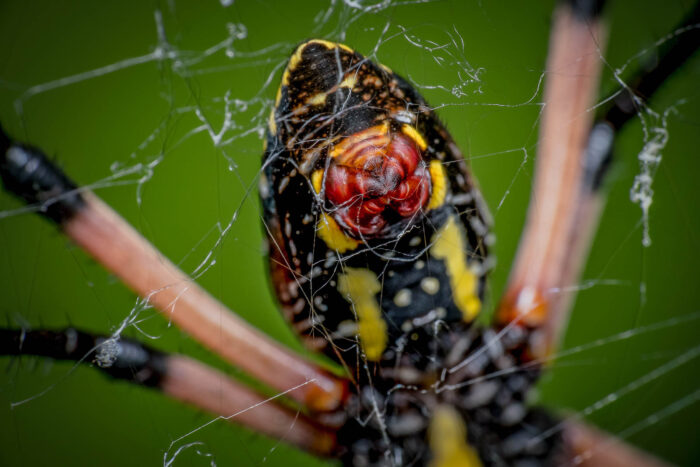Yellow Garden Spider
Argiope aurantia
The yellow garden spider is a striking black and yellow spider that builds orb-shaped webs.
This section shows one large critter image at a time. Use the thumbnails that follow to select a specific image to display here.

This gallery contains a grid of small thumbnails. Selecting a thumbnail will change the main image in the preceding section.
Appearance
Females can be up to three times the size of males. Females have black abdomens with bright, symmetrical yellow patches and black and yellow legs. Males tend to have more brown coloration than bright yellow. Both have a gray cephalothorax covered in short hairs. Yellow garden spiders have three claws per foot, which is one more claw per foot than most spiders but normal for all spiders in the orb weaver family.
Feeding
Yellow garden spiders are considered orb weavers, which is a group of spiders that build orb-shaped webs. The webs are used to catch prey and can be up to two feet wide. Yellow garden spiders produce a venom that is harmless to humans but toxic to small insects. When insects land in the web, the spiders will bite them and wrap them in the silk. When the insect is dead, the spiders will eat them. Yellow garden spiders will often build a new web every day and will eat the silk of the old web each time they take it down.
Predators
Parasitic wasps prey on the eggs of the spider. Birds, lizards and shrews eat adult spiders.
Reproduction and life cycle
Yellow garden spiders mate once per year. Males will approach females and pluck at their web. After mating, the female will lay a clutch of eggs containing several hundred eggs on her web. The timing of the eggs hatching depends on the weather and the location. In warmer areas with mild winters, the eggs will hatch the same year. In colder areas with severe winters, the eggs will go dormant and hatch the following year.
Did you know?
- The webs usually have a zig zag in the middle known as a stabilimentum. The exact purpose of this pattern is not known, but researchers think it might be a way to help birds see the web and avoid flying through it.
- In 2009, a Baltimore Wastewater Treatment plant had an infestation of an estimated 107 million orb weaving spiders. These are normally solitary spiders so this was an incredibly rare instance of communal living.
- Orb weavers can eat twice their weight in insects each day.
Sources and additional information
- National Wildlife Federation - Yellow Garden Spider
- Maryland Department of Natural Resources - Creating a Wild Backyard - Common Spiders of Maryland
- University of Maryland Extension - Spiders in Maryland
